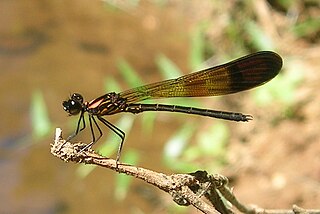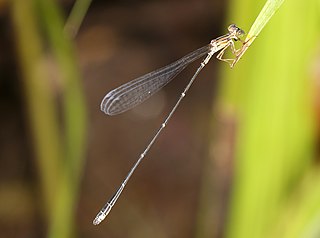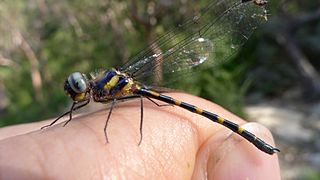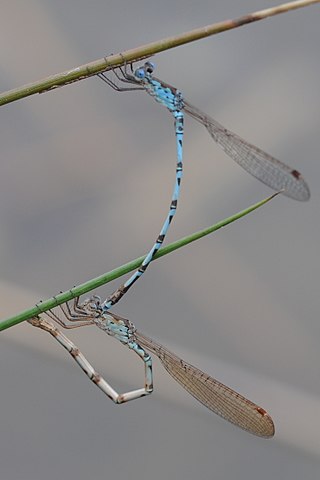
The petaltails of the family Petaluridae are among the most ancient of the extant true dragonflies, having fossil members from as early as the Jurassic, over 150 million years ago. A 2024 molecular phylogeny found that the petaltails comprise two clades, a Gondwanan clade and a Laurasian clade. Their divergence time was estimated at 160 million years ago.

Coenagrionidae or are a family of damselflies, also known as pond damselfies, in the order Odonata and the suborder Zygoptera. The Zygoptera are the damselflies, which although less known than the dragonflies, are no less common. More than 1,300 species are in this family, making it the largest damselfly family. The family Coenagrionidae has six subfamilies: Agriocnemidinae, Argiinae, Coenagrioninae, Ischnurinae, Leptobasinae, and Pseudagrioninae.

The Lestidae are a rather small family of cosmopolitan, large-sized, slender damselflies, known commonly as the spreadwings or spread-winged damselflies.

The Platycnemididae are a family of damselflies. They are known commonly as white-legged damselflies. There are over 400 species native to the Old World. The family is divided into several subfamilies.

Ictinogomphus is a genus of dragonflies in the family Gomphidae. They are medium to large, yellow and black with clear wings. Species occur in Africa, Asia and Australia.

Macromidia is a genus of dragonfly in family Synthemistidae, which is earlier treated as a subfamily of Corduliidae. According to World Odonata List, this genera is best considered incertae sedis. It contains the following species:
Protoneuridae was formerly considered a family of damselflies. Recent taxonomic revisions have classified the species previously placed in Protoneuridae into two existing families - Coenagrionidae and Platycnemididae, both in the superfamily Coenagrionoidea.

Chlorocyphidae is a family of damselflies, commonly known as jewels. These are colorful species native to the Old World tropics, where they occur along forest streams. They are most diverse in Southeast Asia.
The Megapodagrionidae are a family of damselflies, commonly called flatwings for their habit of spreading out the hind wings horizontally when at rest.

Platystictidae is a family of damselflies, commonly known as shadowdamsels. They look very similar to the threadtail damselfly family (Protoneuridae). They can mostly be found throughout Asia, Central America, and South America.

Isostictidae is a family of small to medium-sized damselflies restricted to Australia, New Caledonia, and New Guinea. It contains 12 genera and more than 40 species. Members of this family resemble species in the threadtail family (Protoneuridae).

The Synthemistidae are the family of dragonflies commonly known as tigertails, or sometimes called southern emeralds. This family is part of the superfamily Libelluloidea.

The Lestoideidae are a family of damselflies occurring in South-east Asia, New Guinea and Australia. The family comprises two genera and nine species.

Coenagrionoidea is a superfamily of closed wing damselflies of the order Odonata found worldwide.

Diphlebiidae is no longer recognised as a biological family. It was the name given to a small family of damselflies, the azure damselflies, with species in two genera: Diphlebia and Philoganga. Diphlebia is found in Australia and Philoganga is found in Southeast Asia. They are large and thick-bodied damselflies. They rest with their wings spread out. The Diphlebiidae were also known as Philogangidae.

Libelluloidea is a superfamily of dragonflies.

Cordulephya is a genus of dragonflies assigned to the superfamily Libelluloidea, and endemic to eastern Australia. The species are small to tiny in size, coloured black, or purplish-black, with yellowish markings. Unusually for Anisoptera, these dragonflies rest with their wings folded above their body in a similar manner to many species of damselfly. They are commonly known as shutwings.
Cordulephyidae was formerly considered a distinct family of dragonflies occurring in Africa and Australia. Recent taxonomic revisions have classified the species previously placed in Cordulephyidae to now be within the superfamily Libelluloidea.
Austrocorduliidae was formerly considered a family of dragonflies occurring in South Africa and Australia. Recent taxonomic revisions have classified the species previously placed in Austrocorduliidae to now be within the superfamily Libelluloidea.

Lestoidea is a superfamily of damselflies of the order Odonata. It includes four families:
















